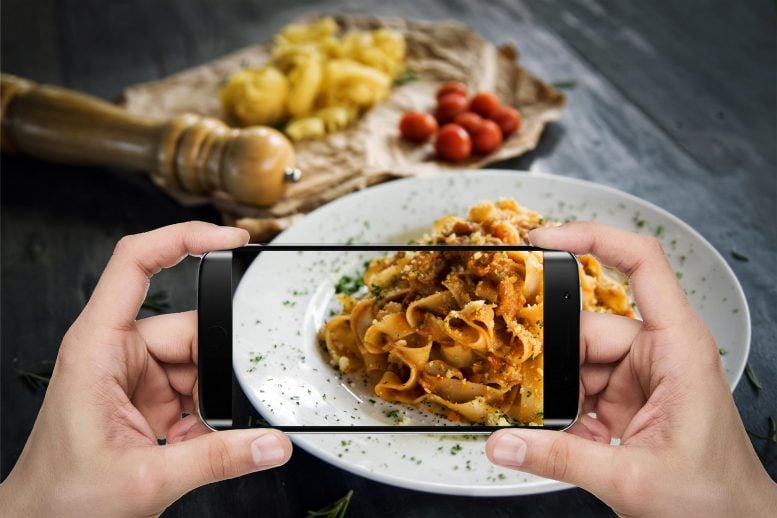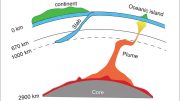
MIT engineers are working on an app that identifies and quantifies food content, which can aid in carbohydrate counting for people with diabetes. Credit: MIT News, stock images
MIT engineers are working on a new kind of device that could streamline the process of blood glucose measurement and insulin injection.
MIT researchers have created two devices to streamline diabetes management. The first integrates several tools into one, enabling glucose measurement and insulin delivery through a smartphone app. The second device, still in development, uses a single needle for both glucose sensing and insulin injection, aiming to simplify and reduce the pain involved in daily diabetes care.
Before consuming a meal, many people with diabetes need to inject themselves with insulin. This is a time-consuming process that often requires estimating the carbohydrate content of the meal, drawing blood to measure blood glucose levels, and then calculating and delivering the correct insulin dose.
Those steps, which typically must be repeated for every meal, make it difficult for many patients with diabetes to stick with their treatment regimen. A team of MIT researchers has now come up with a new approach to streamline the process and help patients maintain healthy glucose levels.
“Any intervention that makes it easier for patients to receive therapy can have an enormous impact, because there are multiple barriers that have to do with time, inconvenience, dexterity, or learning and training,” says Giovanni Traverso, the Karl van Tassel Career Development Assistant Professor of Mechanical Engineering at MIT and a gastroenterologist at Brigham and Women’s Hospital. “If we’re able to overcome those barriers through the implementation of new engineering solutions, it will make it easier for patients to receive that therapy.”
Advanced Devices for Simplified Diabetes Care
Traverso and his colleagues designed two different devices that can simplify the process of calculating and injecting the correct dose of insulin. One, which combines many of the existing steps into a single device, could be used in patients in the near future. Their second prototype incorporates flexible electronics onto the surface of a needle so that the blood measurement and insulin delivery can happen through the same needle. This could eventually make the process of managing diabetes even more streamlined.
MIT postdocs Hen-Wei Huang and Sean You, and visiting students Luca Di Tizio and Canchen Li, are the lead authors of the paper, which appears in the Journal of Controlled Release.
Revolutionary All-in-One Diabetes Management Tools
More than 400 million individuals globally and 34 million Americans suffer from diabetes. Long-acting insulin, which helps manage glucose levels over a 24-hour period, and short-acting insulin, which is given at mealtimes, are the two forms of insulin that patients with diabetes often use to control their blood sugar levels. With a glucose meter, patients must first prick their finger to collect blood and apply a drop of that blood to a test strip in order to evaluate their blood glucose levels. In order to calculate and administer the appropriate insulin dosage, they must also estimate the amount of carbs in their meal and integrate this information with their blood glucose readings.
Existing technologies such as continuous blood glucose monitors and insulin pumps can help with some parts of this process. However, these devices are not widely available, so most patients must rely on finger pricks and syringes.
“Every day, many patients need to do this complicated procedure at least three times,” Huang says. “The main goal of this project is to try to facilitate all of these complex procedures and also to eliminate the requirement for multiple devices. We also used a smartphone camera and deep learning to create an app that identifies and quantifies food content, which can aid in carbohydrate counting.”
The research team devised two different types of “all-in-one” devices, both of which incorporate the new smartphone app. Patients first take a picture of the food, and the app can then estimate the volume of food and also the amount of carbohydrates, based on nutrient information from a USDA database.
The first all-in-one device that the researchers designed consolidates many of the existing tools that patients use now, including a lancet for drawing blood and glucose test strips. Once the blood glucose measurement is taken, the device conveys the information to the smartphone app via Bluetooth, and the app calculates the correct insulin dose. The device also includes a needle that injects the correct amount of insulin.
“What our device is doing is automating the procedures to prick the skin, collect the blood, calculate the glucose level, and do the computation and insulin injection,” Huang says. “The patient no longer needs a separate lancing device, glucose meter, and insulin pen.”
Many of the components included in this device are already FDA-approved, but the device has not been tested in human patients yet. Tests in pigs showed that the system could accurately measure glucose levels and dispense insulin.
A Single Jab
For their second device, the researchers wanted to come up with a system that would require just one needle prick. To achieve that, they designed a novel glucose sensor that could be incorporated into the same needle that is used for insulin injection.
“The idea would be that if we can integrate the glucose sensor directly onto the surface of the insulin delivery needle, we would only need one stick for the patient, which minimizes pain and also makes the whole process easier to administer,” You says.
The researchers designed a flexible electronic sensor that can be attached to the needle and measure glucose levels in the interstitial fluid, just below the surface of the skin. Once the needle penetrates the skin, it takes between five and 10 seconds to measure the glucose levels. This information is transmitted to the smartphone app, which calculates the insulin dose and delivers it through the inserted needle.
In tests in the pigs, the researchers showed that they could accurately measure glucose levels with this system, and that glucose levels dropped after insulin injection.
Because this device uses a novel type of glucose sensor, the researchers expect that it will require further development to get to a point where it could be tested in patients. They have filed for patents on both of the systems described in the new study and hope to work with companies to further develop them.
The research was funded by the MIT Department of Mechanical Engineering and Brigham and Women’s Hospital.









Very Interesting.
The worlds largest market for diabetics is the Indian Sub Continent.
The Pricing for such devices in South Asia has to be aligned with the Purchase Pricing Parity (PPP) in the customer space. Most of the patients in these developing and poorer nations will likely come from people with lower self control as far as food intake is concerned. MOstly thepoorer sections of society and the ultra rich as well.
This is a regular mistake made by most mutinational companies in their choice of profit models. Tying to make too much money too fast ! This leads to great resistance to using such state of the art innovations. What they forget is the real profits lie in a lifetime customer loyalty.
Free market proponents need to understand profit models taught by that smart professor at Harvard, and realise that such profit and buisness models are universal in nature and apply as much in poorer and less eveloped economies with appropriate modifications.
Views expressed are personal and not binding on anyone.
Wouldn’t it be better to just fix medical insurance so that all diabetics can have a CGM?
That would reduce profits for those shareholders. We can’t have a healthy functioning population. Where’s the profit in that? A broken system.
Absolutely correct. The people with the most restricted access to good nutrition and nutritional education are those who need these devices the most, yet they are priced as to make it so difficult to access. The US Healthcare system is ridiculous.
Why not just eat foods, that don’t raise your blood sugar in the first place. I am 71, I have controlled my diabetes without a single pill ever in my mouth for the past 5 years. Just eat low carbs and high fat and protein twice a day, no breakfast. Why complicate ? If I can do it at 71, why not other people ? I don’t have to worry about my weight either, I lose weight with low carb high fat food, in other words go KETO or low carbs. Less than 50 carbs a day does the job. No pills, no insulin, no more pricking fingers. Simple, easy, no money.
There are many devices around to help insulin dependent patients. Unfortunately a lot of insurance co. Will not cover them. A cgm is a good example. The cgm takes a glucose reading every 5 minutes versus 4-6 times daily that most insurance covers. Compare that to driving a car, is it safer to watch the road constantly or once every hour or three? There are also insulin pumps that work with the cgm that requires only input on carb count of food intake. There are many insurance co
That will not cover a cgm and some will not cover a pump. These tools lead to better blood sugar control. Which leads to fewer complications, and fewer doctor visits and or hospital visits. Insurance coverage is tantamount to people having access to tools and medications. We have seen the death of meds and devices that would have benefited many people
Mohinder Sidhu you are SPOT ON with your comment!
Have been thinking about Prviding Automated Solution for Daibetes, since this food and Diet control Solution, proposed by the Team at MIT.
Sharing somme thoughts which might mmake the Disease BOTH Type I and Both Type II Daibetes extinct during the lifetime of a person. Dediated to all medical device manufacturing Companies like Ethicon!! AND Others
Two Players.. 1. Insulin released by the Pancreas/Liver and 2. Sugar in Blood Damaging Cells which need enegy to survive. Imbalance in the same is Diabetes. Autoimmune Disease
For Type I. We need a Blood Sugar monitoring Devicce and Insullin release Patch for automating the release in line with food consuemed.
For TYpe II. We need to determine the Root Cause of wheher the Excess Blood Sugar is due to
excess Sugar Production flooding the Blood Stream immapiring the ability of the Insulin to handle the Sugar-Energy Bio mechanism in the blood of the Patient OR impairment of INsulin.
Best of Luck
Views Expressed are personal and not binding on anyone!